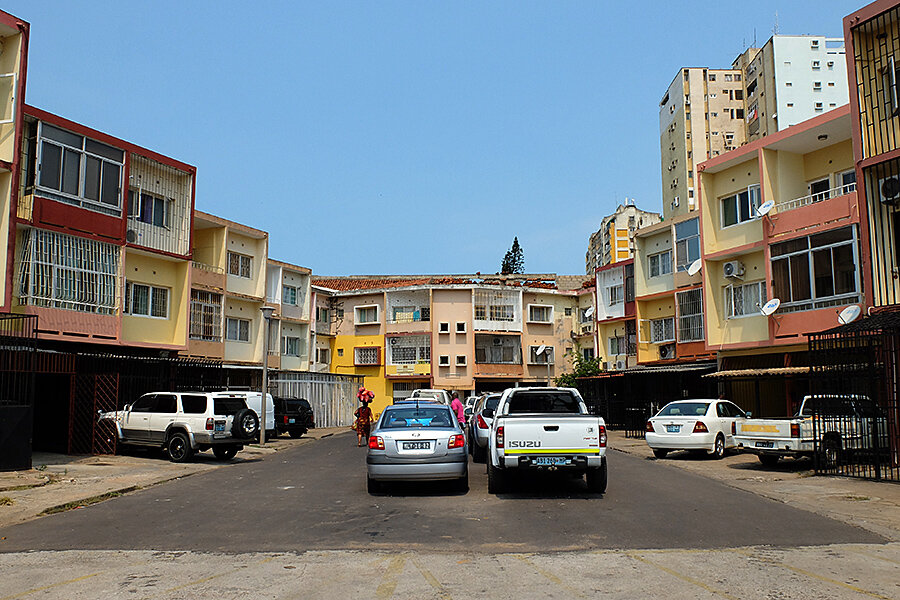In Mozambique, construction boom bulldozes history
| Maputo, Mozambique
Walter Tembe, a Maputo architect, was leading his weekly building tour this past February when he was startled to find one of the city’s treasures had disappeared.
Other than a curved archway, little remained of what had, just a week before, been a rare example of the Tropical Modern style, a style of architecture similar to Art Deco, that was popular in Maputo in the decade before independence in 1975.
Designed in the 1960s by Pancho Guedes — in his day one the Lusophone world’s most famous architects — the building was razed to make way for one of the luxury condominiums popping up throughout the city. Mr. Tembe, whose been leading architectural tours for five years, sees the destruction of the house as the latest example of misguided real-estate development trampling his city's history.
“In the past two years Maputo has seen 50 structures of historical significance destroyed or marked for destruction,” says Tembe. “If we preserved our old buildings, especially the Art Deco buildings, we would have a little Miami."
Though the Portugese started arriving in Mozambique in the 15th century, it was only in the late 19th century that they began to take an interest in Lourenco Marques, now Maputo, following a mining boom in southern Africa. Maputo today is still home to some of the most unique and varied architecture in Africa: from the elegant Hotel Polana Serena to the Casa de Ferro, a steel structure designed by Gustave Eiffel a few years after completion of his famous tower in Paris.
The recently restored Maputo Railway Station, often called one of the most beautiful in the world, was featured in the 2006 Leonardo DiCaprio film “Blood Diamond.”
Guidebooks all acknowledge the beautiful architecture dotting the city, but it has been difficult to convince the Mozambican government, and the city's residents, of the same thing.
Discoveries of natural gas and coal have driven a new era of economic growth. The ruling FRELIMO party has channeled much of the new investment to real estate and infrastructure, which accounts for 5.8 percent of GDP. Some $25 billion worth of construction projects are ongoing in the country, with the nation’s most valuable real-estate in Maputo.
Coupled with the arrival of Lusophone immigrants from Brazil and Portugal, a growing middle class means that new condominiums and apartment towers are in demand.
“Historic buildings from the colonial period are part of our story and they play an important role in the country's development," says Antonio Chitosoto, a local architect. "With them, we could show our children the living proof of the development of this country."
Economic boom
In the past half-decade, Maputo has seen purchase prices for real estate and rents double in dollar terms.
“The prospect of a commodities boom in Mozambique is creating societal pressures on the government to distribute wealth,” says Greg Cohen, director of Asoko Insight, an Africa-focused market research group. “Maputo real estate prices have already seen a significant boost as a result.”
Improving economic fortunes have attracted a large number of Portuguese (the unemployment rate in Portugal was in double digits last year), Brazilians, and South Asians. With them have also come a taste for more modern architecture.
There doesn’t seem to be much activism or opposition to the destruction of this history, says José Forjaz, a local architect who has studied the city’s architecture from an anthropological perspective. He believes “there should be no contrast between preservation and development.”
He says it's hard to convince Mozambicans to empathize with the historic architecture because there is more interest in the future of Maputo than the past. The country has seen roughly two decades of peace after a brutal 15-year civil war. But some say they have little to show for it.
“We live in a continent where the past is not a good remembrance and the future is the only redeeming hope,” he says. “And the present a source for tears.”
Any petitions to save buildings occur behind closed doors by architects with connections to the ruling party, but such efforts only delay the inevitable in most cases.
The government affirms that it is committed to preservation, but it is hard finding funds to pay for it. Most restoration is handled by the private sector. "When the funds become available to us, more work will be done,” an official at the Ministry of Tourism says.
Preserving Guedes
Today, many of Mr. Guedes's buildings and other historic sites are badly in need of repair. He, more than any other architect, has left his mark on Mozambique.
“People during this period would tell other architects, build me something like Pancho Guedes” says Tembe of Guedes' peak in the 1960s..
In all, Guedes designed 500 buildings in the country. Just over 100 still stand in Maputo but many sit in areas where developers have started new real estate projects such as in Polana Hill, one of the most expensive areas in the capital.
Under current law, only buildings constructed before 1920 fall under protected status. Thus, Art Deco buildings and most of Guedes’s work aren't covered — like a house that was once a meeting place of the anticolonial resistance and the Casa Coimbra, a historic department store built in the Art Deco style in the 1930s.
The government is “more concerned with making money from their new construction projects,” Tembe says.
Thinking of his own architectural tour, he says: “There are 112 Pancho Guedes structures in Maputo … well, last week. Now there are 111.”






